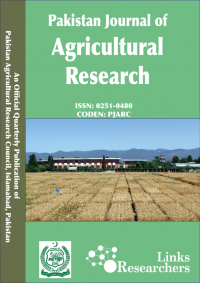EFFECT OF DIFFERENT SOWING METHODS AND PLANTING DENSITIES ON GROWTH, YIELD, FIBER QUALITY AND ECONOMIC EFFICACY OF COTTON
Ehsanullah*, Muhammad Amjad Shahzad*, Shakeel Ahmad Anjum*, Ali Zohaib*, Muhammad Ishfaq* and Ejaz Ahmad Warraich*
ABSTRACT
Crop growth and productivity may differ under different sowing methods and planting densities. A field experiment was conducted to evaluate the influence of different sowing methods and planting densities on growth, yield, quality and economic returns of cotton. Sowing methods included pit planting (1 m × 1 m pits), bed planting (75 cm apart beds), ridge planting (75 cm apart ridges) and line sowing with varied inter row spacing (25, 50 and 75 cm). Sowing methods significantly affected growth and yield of cotton. Pit planting imposed maximum increase in plant height (152 cm), number of monopodial branches (4.7) and sympodial branches (22.6) per plant, number of unopened (9.4) and opened bolls (41.1) per plant, and average boll weight (3.0 g) of cotton. However, highest seed cotton yield (2944.5 kg ha ) was obtained by flat sowing on 25 cm apart rows owing to highest planting density per unit area. Maximum ginning out turn (GOT) (41.6%) was noticed in pit planting of cotton, while, fiber quality was not affected significantly by sowing methods. Economic analysis showed that economic returns and benefit cost ratio (BCR) (1.52) was elevated by flat sowing on 25 cm apart rows. In conclusion, maximum seed cotton yield and economic returns can be acquired by flat sowing with 25 cm apart rows, while, fiber quality is independent of sowing methods.
To share on other social networks, click on any share button. What are these?






